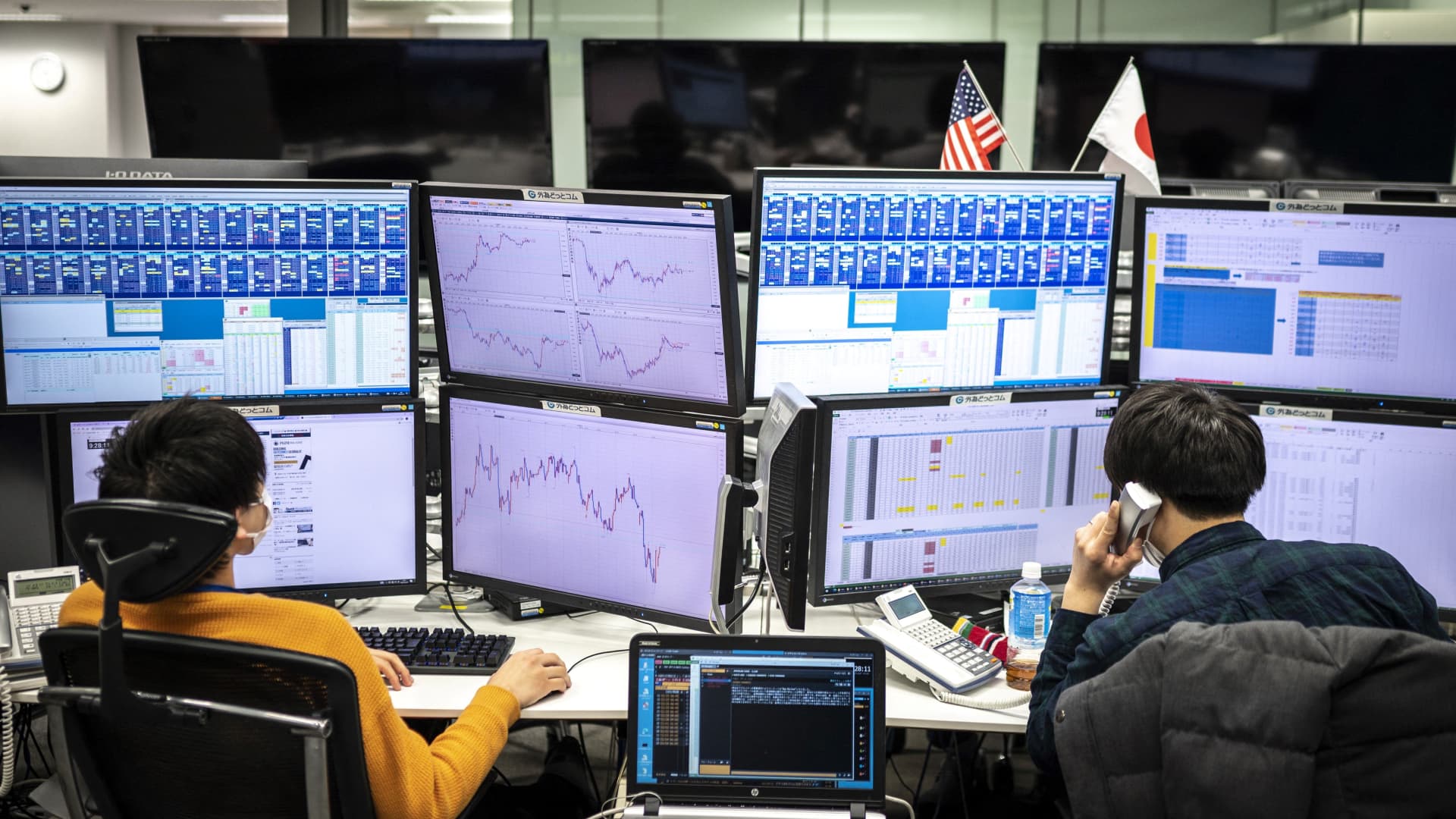Technology stocks in Asia-Pacific fall; 10-year U.S. Treasury yield surges

SINGAPORE — Technology stocks in Asia-Pacific declined in Wednesday trade, mirroring losses seen among their peers on Wall Street following an overnight surge in the U.S. 10-year Treasury yield.
Chinese tech stocks in Hong Kong dropped in Wednesday trade, with Alibaba falling 4.57% and Meituan declining 2.75% while Tencent shed 2.15%. The Hang Seng Tech index traded 3.4% lower.
In Japan, shares of SoftBank Group shed 2.81%. Over in South Korea, Kakao shares declined 2.33% and Naver slipped 3.65% while SK Hynix fell 3%.
Those losses in Asia came after the tech-heavy Nasdaq Composite lagged overnight on Wall Street, dropping 2.26% to 14,204.17.
The broader Asia-Pacific markets also traded in negative territory on Wednesday.
Hong Kong’s Hang Seng index dropped 1.42%. Hong Kong’s chief secretary John Lee resigned on Wednesday, 2 days after incumbent Hong Kong leader Carrie Lam announced Monday she will not pursue a second term in office. Local media reports have cited unnamed sources saying Lee is set to join the chief executive race.
Mainland Chinese stocks closed mixed as they returned to trade following holidays earlier in the week. The Shanghai composite was marginally higher at 3,283.43 while the Shenzhen component shed 0.45% to 12,172.91.
The Covid-zero policy is probably the most important uncertainty that we’re watching at Eastspring right now but generally speaking, we do think there’s a good opportunity for investors that want to get back in to China.
Sarah Lien
client portfolio manager, Eastspring Investments
Chinese services sector activity saw a sharp contraction in March, a private survey showed Wednesday. The Caixin services Purchasing Managers’ Index declined to 42.0 in March, well below February’s reading of 50.2 as well as the 50 mark that separates growth from contraction on a monthly basis. Wednesday’s reading was also the lowest since February 2020.
That data release comes as China continues to battle its worst Covid outbreak since the beginning of the pandemic in early 2020.
“The Covid-zero policy is probably the most important uncertainty that we’re watching at Eastspring right now but generally speaking, we do think there’s a good opportunity for investors that want to get back in to China,” Sarah Lien, client portfolio manager at Eastspring Investments (Singapore), told CNBC’s “Street Signs Asia” on Wednesday.
“Even though … there’s a lot of worry in the markets, we do think it’s priced in, we do think there’re opportunities … and we think China’s just a great diversifier … in global portfolios,” Lien said.
In Japan, the Nikkei 225 slipped 1.58% to close at 27,350.30 while the Topix index fell 1.34% to end its trading day at 1,922.91. South Korea’s Kospi dipped 0.88% to end the trading day at 2,735.03.
Elsewhere, the S&P/ASX 200 in Australia declined 0.5%, closing at 7,490.10.
MSCI’s broadest index of Asia-Pacific shares outside Japan traded 1.06% lower.
U.S. Treasury watch
Investors continued to monitor moves in U.S. Treasurys on Wednesday. The 10-year Treasury rose to its highest level since May 2019 on Tuesday, hitting a high of 2.562% before settling at 2.55%.
The yield on the benchmark 10-year Treasury note last sat at 2.6087%, well above the 2-year Treasury note’s yield of 2.5653%. Yields move inversely to prices.
A topping of the 2-year Treasury yield against the 10-year rate, which happened last week before the recent reversal, has historically been observed ahead of recessions.
The 10-year Treasury yield jumped overnight after comments from U.S. Federal Reserve Governor Lael Brainard suggested an aggressive approach to shrinking the central bank’s balance sheet.
“Brainard peppered her comments on balance sheet reduction with adverbs that added to the hawkish perception. In addition, that the reduction may start in May is earlier than expected,” Frances Cheung and Terence Wu of Singapore’s OCBC Treasury Research wrote in a note.
“We are likely not at peak-hawk at the Fed yet. This dynamic could still extend,” they said.
Currencies and oil
The U.S. dollar index, which tracks the greenback against a basket of its peers, was at 99.664 following a recent jump from below 99.
The Japanese yen traded at 123.90 per dollar, weaker as compared with levels below 123.3 seen against the greenback yesterday. The Australian dollar changed hands at $0.7588 after a recent drop from above $0.762.
Oil prices were mixed in the afternoon of Asia trading hours, with international benchmark Brent crude futures up 0.1% to $106.75 per barrel. U.S. crude futures shed 0.16% to $101.80 per barrel.
